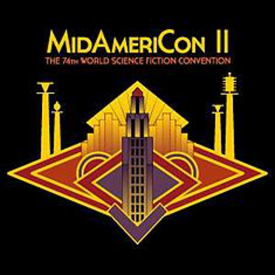And I’m still not done talking about cons! Continuing with our talk about cons that have grown out of the SF con, we have things like Steampunk and Anime cons.

Steampunk arose from the idea that if science had been a bit more like today’s science in the 19th century, perhaps powered by steam instead of gasoline or electricity—along with a “more civilized” or “genteel” population—things might have been more fun. Because there was no real Nautilus, one could consider Jules Verne’s 20,000 Leagues Under the Sea to be—as well as its sequel, The Mysterious Island—a real steampunk novel. One of the first acknowledged steampunk novels is the William Gibson/Bruce Sterling collaboration, The Difference Engine. For most people, steampunk gives them the opportunity to wear 19th-century clothing, with additions like goggles, and to carry fake weaponry. It’s both a costuming and a role-playing thing. Oddly enough, corsets are a big hit with the steampunk crowd, although many of them are worn outside the clothing, where no proper Victorian would ever wear them. There are a number of cons catering to the steampunk crowd; one of the first is a Seattle-are convention called Steamcon.
Another offshoot convention is the anime convention. Because of the popularity of Japanese animation in the West, probably going back to Astro Boy in the ‘60s, and the Gundam stuff in the ‘80s, as well as the Transformers series, Japanese anime is extremely hot, and has many thousands of adherents in the Western world. It’s popular, like steampunk, with role players, costumers and so on. (Best of all, with anime’s rise, we of the West have been exposed to the incredible art and storytelling of Hayao Miyazaki and Studio Ghibli.)
There have been SCA events and tournaments for many years; based on the idea that the Middle Ages were a lot more fun than we give them credit for, a lot of people have created personas of the period, both common and noble, and set about recreating the Middle Ages as they should have been. The Society for Creative Anachronism comes complete with Lords and Ladies, Knights, jousting, chivalry, pageantry, heraldry and all kinds of stuff I probably don’t even know about. If that sounds attractive to you, I urge you to Google the SCA and find your local dukedom. (Some of the nicest people I know like to ride horses and bash each other with padded axes and the like!)

Earlier, I mentioned “filk.” Like many things in fandom, the word “filk” arose out of a typo. Remember that fandom was originally written-word based, back in the day when the most exciting SF fare on TV was “Captain Video” and Willis O’Brien’s stop-motion dinosaurs were the Jurassic Park of their day. (I’m not dissing Captain Video, which has lots of adherents.) Anyway, someone (https://www.filk.com/filk101_index.html) typoed “folksinging” in a convention program, and that’s all she wrote. Loosely put, “filk” is short for “filksinging,” which originally involved writing SFnal* lyrics to well-known tunes, but has evolved into a society all its own, with its own cons, its own tunes, its own culture and its own luminaries. My own introduction to filk came in 1975, when—as a curious neo, I saw it listed in the Westercon 28 program book and went up the stairs to the filk room to find Erwin S. “Filthy Pierre” Strauss leading the room in a spirited rendition of Robert A. Heinlein’s “The Green Hills of Earth”—set to the tune of “Gilligan’s Isle.” Ahem. Many SF cons have a filk room and a filk program; try it, you just might like it!
(*SFnal: if you substitute “science fiction” for SF in this word and pronounce it, you’ll get “science-fictional.” Hey, there is some method in my madness after all!)
I’m sure I’m forgetting something major in my rush to expose you to all facets of the fannish life. That’s okay; someone will tell me in no uncertain terms what a dolt I am—and with luck, they’ll provide me with enough information for a follow-up to these blogs. So rest assured this won’t be the full extent of my conversations on convention going.
Getting back to the general SF convention; one of the things that has always attracted me to SF is the art; first on book covers and magazines—as a very young man, I used to scour Ace Doubles for Ed Emshwiller’s signature “EMSH,” which he hid in the paintings—then, after I started going to cons, in the art shows. A Very Good Thing about con artshows is that you will see art not only by professional artists, some of which has been published as cover art, but by some very talented amateurs. A good convention artshow will have not only two-dimensional art, like sketches, drawings and paintings, but also three-dimensional art. I’ve seen sculptures—in every possible medium—costumes, fabrics; in fact, almost anything a person might do in the form of creativity. And here’s the great thing: most of it is for sale!

While the art is hanging, you might notice “bid tags” attached to it or nearby. On these tags are generally several things: the piece’s name, its medium, the artist’s name, and either the words “NFS” (Not For Sale) or a price—or even two prices! If there is a single price, it’s usually the minimum bid, because most art in an artshow goes up for auction on the last day of the con. (Some also have a “direct sale” price for those with lots of money who want to pre-empt the auction by just buying it. Direct sale prices are usually much higher than the minimum and much more in line with what the artist feels that piece is worth. A minimum bid is lower in hopes of sparking some spirited bidding that will raise the piece’s price.) I’ve auctioned art at various cons since 1978; pieces ranging from a single dollar up to many thousands of dollars (a piece by Leo and Diane Dillon at ConText ’89).
That’s not the only auction you might find at a con, however; there’s a long-standing tradition at many of the larger cons to fund either worthy charities or to fund travel for fans to various cons; there are the Down Under Fan Fund (DUFF), the TransAtlantic Fan Fund (TAFF), the Canadian Unity Fan Fund (CUFF) and the Going Up and Over/Under Fan Fund (GUFF). Each of these funds has various methods of raising money to help send fans in one direction or another across the ocean or a continent so that they may report on the happenings there; in fact, a report is a requirement of winning.
Besides the artshow (sometimes called the Art Gallery), you might find an idea which started at comic cons, and migrated to the mainstream SF cons: the Artists’ Alley. I’ve mentioned that there are many amateur artists in SF; and another way for them to gain exposure besides the artshow is the Artists’ Alley, which is basically a well-traversed area in the convention hotel or venue, not a function room, housing tables behind which sit artists and entrepreneurs of various kinds who will provide “instant art” for you, sell you their crafts and/or arts, and basically provide (in my “humble” opinion) a fun, barely-regulated experience that’s sort of disconnected from the main con activity.
I mentioned room parties in one of my previous blogs. When you go to a con—and again, I’m not speaking of commercial conventions, as I have no experience of them—you will often see either signs taped to walls or a notice board, advertising room parties. Some of these are put on by conventions hoping to attract you or your vote (convention sites are often voted on: the World Convention is voted on by members of a previous convention, as are Westercon and the NASFIC (the North American alternative to the Worldcon when the Worldcon is held outside North America). Some are put on by people who just like to host parties and see who comes. Some are just private parties, and you need to know someone to get in. They’re not usually that hard to find or to get invited to. Back in the Old Days, when people drank and smoked and fooled around—not like today, where we’re all sober, upright citizens—you would usually find the hotel halls full of inebriated people after the business of the day was completed; room parties often went from around 8 p.m. to whenever. Most cons had a “party wing” and if you didn’t like noise, you were advised when checking into the hotel to ask for a “quiet wing” room. Nowadays things are more sedate and, besides checking ID before serving anything alcoholic, the noise levels are considerably less. But parties abide, and they’re one of the fun things at cons where, if you behave yourself, you can find yourself interacting with some interesting people, even Big Names.
And then there’s Hospitality. With a capital “H,” no less. (As opposed to the Green Room, which many large cons have. The Green Room is for panel participants to relax and chat away from the general populace. It’s kind of a perk some cons offer.) The Hospitality Room or Suite is generally one or two larger rooms that have been cleared of beds and stuffed with tables and chairs. It’s where you can usually get, for a contribution, a drink (soft or beer, depending on the con and your age), coffee, tea and/or snacks. It’s a place to relax and meet other congoers in a sometimes quieter location than a panel room, a bar or other venue. For some, it’s a refuge. For others, it’s a break from a hectic con schedule. It’s also called the “Con Suite,” as in “Meet me in the Con Suite,” as a good place to find someone. Because the astute congoer will turn off his or her cell phone while they’re in panels, to avoid disturbing everyone else.
Another thing you’ll find at every con I’ve ever been to is the dealers’ (or “hucksters’”) room (now sometimes called the “Vendors’ Room”), which is basically a room or rooms set aside by the con for people to sell you stuff. What kind of stuff? Almost any kind of stuff you might think of that’s even vaguely SF related! I’ve seen costumes—hand-made high-quality costumes, blades and swords, armour, games, authentic relics of Olde England and Norse items, hats, coffee mugs, books, magazines, CDs and DVDs and other kinds of collectibles; in short, whatever they think you’ll buy! (I’ve even hawked my own books at a couple of dealers’ rooms; you meet the nicest people, both dealers and customers, in a dealers’ room!) When I started going to conventions there were originally as many book dealers as vendors of costumes and collectibles; sadly, the number of booksellers has declined markedly. Which pains me, because I’m a book reader and a book collector.

I’ve probably forgotten some salient point about going to cons; that’s all right because (a) I’ve been doing them for a long time and after a few years everything kinda blurs together, and (b) someone is bound to remind me. And you already know my email (stevefah@hotmail.com) and can message me there or through the Amazing Stories website. Just be nice, okay?
Next time I think we’ll take a break and look at a few recent fanzines. I have some from both sides of the Atlantic; I’ve never found a fanzine that didn’t have some content that I wanted to read. That says a lot about a lot of people.
So until next time, “Hot jets and clear ether!” (Yeah, I know. I’m stuck in the past. I love it!)











1 Comment